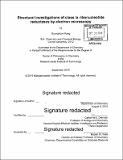Structural investigations of class la ribonucleotide reductases by electron microscopy
Author(s)
Kang, Gyunghoon.
Download1135348734-MIT.pdf (20.80Mb)
Other Contributors
Massachusetts Institute of Technology. Department of Chemistry.
Advisor
Catherine L. Drennan.
Terms of use
Metadata
Show full item recordAbstract
Ribonucleotide reductase (RNR) catalyzes the reduction of nucleotides to their 2'-deoxynucleotide counterparts. The class la RNR from Escherichia coli is composed of two homodimeric subunits [alpha]2 and [beta]2 that form an [alpha]2[beta]2 complex to perform nucleotide reduction. Chemistry is initiated by a thiyl-radical (C439·) in the active site of [beta]2 that is reversibly generated by a diferric-tyrosyl radical cofactor (Y122·) in [beta]2 by a series of proton-coupled electron transfer steps: Y122[beta] <-> [W48[beta]] <-> Y356[beta] <-> Y731[alpha] - Y730[alpha] - C439[alpha]. A high-resolution structure of the active [alpha]2[beta]2 complex has long eluded the field due to the weak and transient nature of the a2-P2 interaction. Previous studies revealed that perturbing radical transfer by incorporating unnatural amino acids along the transfer pathway, or by using mechanistic inhibitors that trap the radical in the active site, can extend the lifetime of the [alpha]2[beta]2 complex, allowing for structural studies. Here, we present our efforts to study the E. coli class la RNR [alpha]2[beta]2 complex, trapped using these different perturbation methods, using cryo-electron microscopy. The two [alpha]2[beta]2 structures presented here provide deeper insight into the structural dynamics of nucleotide reduction. We end with a brief discussion of class la RNR from T4 bacteriophage, which despite sharing high sequence identity to its host E. coli class la RNR, employs a very different mode of oligomeric regulation.
Description
Thesis: Ph. D., Massachusetts Institute of Technology, Department of Chemistry, 2019 Cataloged from PDF version of thesis. Vita. Includes bibliographical references.
Date issued
2019Department
Massachusetts Institute of Technology. Department of ChemistryPublisher
Massachusetts Institute of Technology
Keywords
Chemistry.